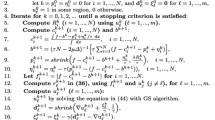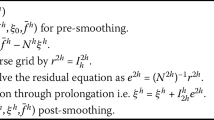Abstract
In this article we present an approach to the segmentation problem by a piecewise approximation of the given image with continuous functions. Unlike the common approach of Mumford and Shah in our formulation of the problem the number of segments is a parameter, which can be estimated. The problem can be stated as: Compute the optimal segmentation with a fixed number of segments, then reduce the number of segments until the segmentation result fulfills a given suitability. This merging algorithm results in a multi-objective optimization, which is not only resolved by a linear combination of the contradicting error functions. To constrain the problem we use a finite dimensional vector space of functions in our approximation and we restrict the shape of the segments. Our approach results in a multi-objective optimization: On the one hand the number of segments is to be minimized, on the other hand the approximation error should also be kept minimal. The approach is sound theoretically and practically: We show that for L 2-images a Pareto-optimal solution exists and can be computed for the discretization of the image efficiently.
Similar content being viewed by others
References
P.J. Besl and R.C. Jain, “Segmentation Through Variable-Order Surface Fitting.” IEEE Transactions on Pattern Analysis and Machine Intelligence, Vol. 10, No. 2, pp. 167–192, 1988.
A. Blake and A. Zisserman, Visual Reconstruction, MIT Press, Cambridge MA, 1987.
B. Bourdin and A. Chambolle, “Implementation of an adaptive finite-element approximation of the Mumford-Shah functional.” Numerische Mathematik, Vol. 85, No. 4, pp. 609–646, 2000.
D.S. Bridges, Foundations of Real and Abstract Analysis, Springer, New York, 1998.
A. Chambolle, “Image segmentation by variational methods: Mumford Shah functional and the discrete approximations.” SIAM Journal on Applied Mathematics, Vol. 55, No. 3, pp. 827–863, 1995.
A. Chambolle and G. Dal Maso, “Discrete Approximation of the Mumford-Shah functional in dimension two.” Mathematical Modelling and Numerical Analysis (M2AN), Vol. 33, No. 4, pp. 641–672, 1999.
K. Donner: “Hierarchical Approximation for Pattern Recognition.” In Application of Artificial Intelligence, Prague, pp. 213–226, 1991.
N. Fusco, “An Overview of the Mumford-Shah Problem.” Milan Journal of Mathematics, Vol. 71, No. 1, pp. 95–119, 2003.
P.R. Halmos, Measure Theory, Springer, New York, 1974.
T. Hanning, “Nonparametric Segmentation of Grayvalue Images by n-level-set-fitting.” In World Multiconference on Systemics, Cybernetics and Informatics 2000, Vol. V., Orlando, pp. 90–95, 2000.
T. Hanning and G. Pisinger, “A Pixel-based Segmentation Algorithm of Color Images by N-level-fitting.” In 5th IASTED International Conference on Computer Graphics and Imaging, Kauai, pp. 138–144, 2002.
R.M. Haralick and L.G. Shapiro, Computer and Robot Vision, Addison-Wesley, Reading, 1992.
T. Kämpke, “Optimal and Near Optimal Quantization of Integrable Functions.” Computers and Mathematics with Applications, Vol. 40, No. 10–11, pp. 1315–1347, 2000.
T. Kämpke and R. Kober, “Nonparametric Optimal Binarization.” In Proceedings of the 14th International Conference on Pattern Recognition ICPR, Brisbane, pp. 27–30, 1998.
T. Kämpke and R. Kober, “Discrete Signal Quantization.” Pattern Recognition, Vol. 32, No. 4, pp. 619–634, 1999.
G. Koepfler, C. Lopez, and J. Morel, “A Multiscale Algorithm for Image Segmentation by Variational Method.” SIAM Journal on Numerical Analysis, Vol. 31, No. 1, pp. 294–325, 1994.
V. Lauren and G. Pisinger, “Automated analysis of vessel diameters in MR images.” In The 4th IASTED International Conference on Visualization, Imaging, and Image Processing, Marbella, pp. 931–936, 2004.
Y. Leclerc, “Constructing Simple Stable Descriptions for Image Partitioning.” International Journal of Computer Vision, Vol. 3, pp. 73–102, 1989.
J.M. Morel and S. Solimini, Variational Methods for Image Segmentation, Birkhäuser, Boston, 1995.
Mumford, D. and J. Shah, “Boundary Detection by Minimizing Functionals.” In Proceedings of the IEEE Conference on Computer vision and pattern recognition, San Francisco, pp. 22–26, 1985.
D. Mumford and J. Shah, “Optimal Approximation by Piecewise Smooth Functions and Associated Variational Problems.” Communications Pure and Applied Mathematics, Vol. 42, 577–684, 1989.
N. Otsu, “A Threshold Selection Method from Gray-Level Histograms.” IEEE Transactions of Systems, Man, and Cybernatics, Vol. 9, pp. 62–66, 1979.
N. Papamarkos, C. Strouthopoulus, and I. Andreadis, “Multithresholding of Color and Gray-Level Images Through a Neural Network Technique.” Image and Vision Computing, Vol. 18, pp. 213–222, 2000.
J.R. Retherford, Hilbert Space: Compact Operators and the Trace Theorem, Cambridge University Press, Cambridge, 1993.
A. Rosenfeld and A. Kak, Digital Picture Processing Vol. 2, Academic Press, San Diego, 2. edition, 1982.
M.J. Swain and D.H. Ballard, “Color Indexing.” International Journal of Computer Vision Vol. 7, No. 1, pp. 11–32, 1991.
K. Yosida, Functional Analysis, Springer, Berlin, 5. edition, 1978.
Author information
Authors and Affiliations
Corresponding author
Additional information
Tobias Hanning graduated in computer science in 1996 at the University of Passau, Germany. From 1996 to 2001 he worked for the Institute for Software Systems in Technical Applications of Computer Science (FORWISS) and received his doctoral degree in 2001 in image segmentation. From 2001 to 2003 he worked on 3D-reconstruction for the company alfavision. Since 2003 he is a research assistant at the chair of analysis and numerical mathematics of the University of Passau. His current research interests include object segmentation, camera calibration and object reconstruction.
René Schöne was a member of the the Forschungszentrum Juelich (Germany) from 1993 to 1996. Afterwards, he studied mathematics at the RWTH Aachen and received his diploma degree in 2001. Since October 2001 he works as a PhD-student at the Institute for “Software Systems in Technical Applications of Computer Science” (FORWISS) in Passau, Germany. His research topics are applied and numerical Analysis, approximation theory and interdisciplinary applications.
Georg Pisinger studied mathematics at the University of Passau, Germany. He received his diploma degree in 1996 and his Ph.D. in 2003 from the University of Passau. Currently he is a post doctorial research assistant at the University of Passau. His research interests include computer vision, especially the application of image segmentation techniques in science and industry, and approximation theory.
Rights and permissions
About this article
Cite this article
Hanning, T., Schöne, R. & Pisinger, G. Vector Image Segmentation by Piecewise Continuous Approximation. J Math Imaging Vis 25, 5–23 (2006). https://doi.org/10.1007/s10851-005-4385-5
Published:
Issue Date:
DOI: https://doi.org/10.1007/s10851-005-4385-5




